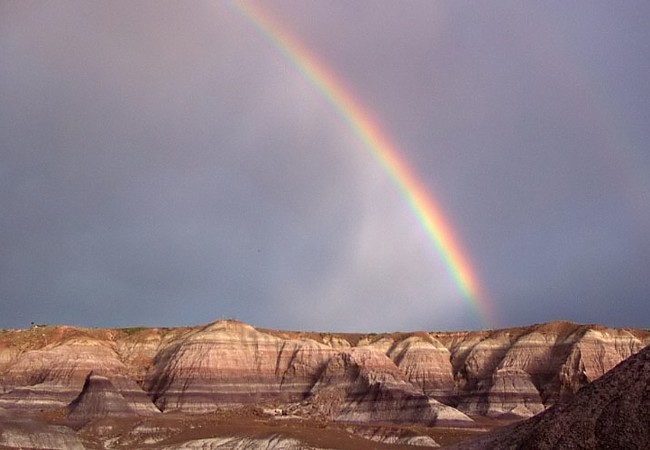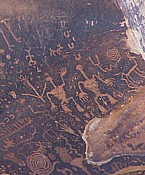|
Scenic USA - Arizona Painted Desert Treasures |

| Photo by Clayton Esterson Clayton's PBase Gallery Inset photo by Alexia Goldman |
It's not likely there's a pot of gold under this rainbow, but what you will find here in the Painted Desert are a cluster of nature's rare treasures. Among this harsh land of colorful sandstone and mudstone layers, visitors are often amazed to discover ancient trees that have turned to stone, fossil remains of giant amphibians, and old petroglyph panels called Newspaper Rock.
Shaped in a 160 mile crescent shaped arc, the Painted Desert begins nearby the Grand Canyon and extends just beyond Petrified Forest National Park. Thick deposits of gray, blue, lavender and green mudstones in the southern Petrified Forest yield to layers of red, orange, and pinks in the Painted Desert to the north. Accented with thin layers of white limestone banding, these sediments were laid down approximately 220 to 225 million years ago.
Recent history shows the area was inhabited about 1250 AD,  housing a number of families. Puerco Pueblo stood one-story high, with rows of nearly 100 connecting rooms, all surrounding a central plaza. The nearby river provided water, sustaining life in this unforgiving land. Pueblo farmers grew cotton, corn, squash, and beans, while hunters tracked down local game. Ancient artists created and decorated clay pots, and also applied their artwork on nearby sandstone rocks. There is a dark coating on the rock, called desert varnish, providing the perfect medium for these petroglyph panels. With sharpened tools, the desert varnish was removed, exposing a lighter rock beneath. Since people have a tendency of defacing such artifacts, the National Park Service provides viewing scopes to see the petroglyphs at a distance. Although the meaning of these rock art figures appear mysterious, recent studies suggest these sites were used as a solar calendar to track our sun‘s yearly movement across the sky.
housing a number of families. Puerco Pueblo stood one-story high, with rows of nearly 100 connecting rooms, all surrounding a central plaza. The nearby river provided water, sustaining life in this unforgiving land. Pueblo farmers grew cotton, corn, squash, and beans, while hunters tracked down local game. Ancient artists created and decorated clay pots, and also applied their artwork on nearby sandstone rocks. There is a dark coating on the rock, called desert varnish, providing the perfect medium for these petroglyph panels. With sharpened tools, the desert varnish was removed, exposing a lighter rock beneath. Since people have a tendency of defacing such artifacts, the National Park Service provides viewing scopes to see the petroglyphs at a distance. Although the meaning of these rock art figures appear mysterious, recent studies suggest these sites were used as a solar calendar to track our sun‘s yearly movement across the sky.
Area Map

|
Additional Points of Interest |
|
Copyright © 2020 Benjamin Prepelka
All Rights Reserved
